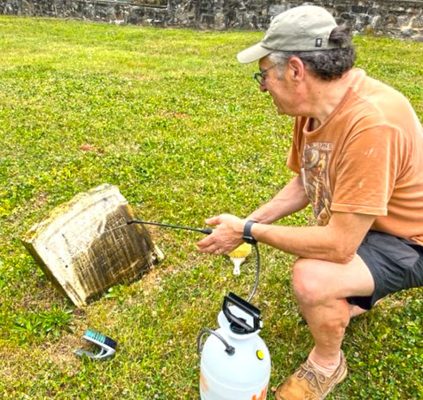The second oldest tombstone in the country – Joseph Sharp’s in 1698 (the oldest was in 1697) – stands in Yardley’s Slate Hill Cemetery, one of the two oldest cemeteries in Bucks County.
Since spring, a volunteer group from the Lower Makefield Township Historical Commission has been revitalizing the cemetery so that more members of our community can safely access this treasure, which was listed on the National Register of Historic Places in 1992.
Led by the team of Tom Argentieri, Joe Camaratta, and Monica Hinden, the volunteers’ first job was to survey the site and clean up the cemetery grounds. During two days in May and June, they removed fallen branches and overgrowth around the base of trees. With the help of the township’s Department of Public Works, dead trees and limbs were removed.
Last March, restoration of the tombstones was begun. The volunteers used a special solution recommended by the National Parks Service. “What I think is so cool about it is, obviously you start with the marker in a terrible state. You spend not long, if not five minutes, scrubbing it, and [rinsing it] with a water-spray bottle. Immediately, you get satisfaction. Wow! That’s a big difference,” says Monica. Speaking of the individuals buried in Slate Hill, “the founders of our community,” Monica believes, “we owe it to them to respect [that which] is still present among us.”
Perhaps the most fascinating aspect of this project is finding out exactly who was buried in Slate Hill Cemetery. The stone wall perimeter has an opening in the middle that allows you to walk between the cemetery’s two sections.
If you’re looking at it from Yardley-Morrisville Road, the right side is the Quaker section, with founder William Yardley likely being its most prominent resident. “There’s no stone for him, but at that time Quakers weren’t using headstones,” explains Monica, “because it was a sign of vanity.”
Yet there is documentation in Yardley’s will that he was to be buried here, in 1693. Local historian Helen Heinz’s goal is to do the necessary research to prove it and procure a tombstone for him.
The left section of Slate Hill is the public side, where the Presbyterians, Methodists, and Baptists were buried. Veterans of the Civil War, including soldiers of the United States Colored Troops, were laid to rest here.
With radar equipment typically used to solve crimes, LMT Police Chief Coluzzi has produced a map for the Quaker side that “appears to be pretty spot on,” reports Monica, in comparison to the oldest documentation available, a 1926 hand-drawn survey.
“It’s incredible, because when you go to Slate Hill, you see it’s really wide open, there are very few stones compared to the amount of space there is,” says Monica. “But when you look at the map, and all the radar hits, there are clear lines, they give us very clear burial sites, and you see really how many there are, it’s full.”
As for the number of headstones currently visible, there are approximately 139, some of them for multiple people on the Quaker side; 40 are on the public side. However, according to the 1926 survey, the record shows 221 burials on the Quaker side.
The most recent burials were of two Quaker women in 1918. The Slate Hill team plans further research to uncover the identity of many of the cemetery’s residents.
The first Slate Hill annual event will be the Ghost Tour on October 14th, from 4:00-8:00pm, with an October 15th rain date. “It’s meant to be a family-friendly event, not spooky,” says Monica. Ten to 12 reenactors, in costume and in character, will portray personages buried in the cemetery.
No registration is required; a donation of $5 is suggested. Slate Hill Cemetery is located on 2308 Yardley-Morrisville Road, where it intersects with Mahlon Drive.
PHOTO CAP: Thomas Argentieri cleans one of the tombstones in Slate Hill Cemetery
